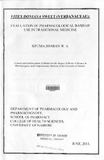| dc.description.abstract | Vitex doniana is a medium sized deciduous tree, 8 to 18 m high, with a heavy rounded crown and a clear pole up to 5 m in height. It is quite wide spread occurring in Savanna regions, Coastal woodlands, riverine and low land forests. It also occurs in deciduous woodlands extending as high as upland grasslands. It is native to Kenya, Angola, Botswana, Lesotho, Namibia, Niger, Senegal, Somalia, South Africa, Sudan, Tanzania, Uganda, Zambia and many others. Ethno botanical uses include: treatment of epilepsy, infertility, eye problems and pain management. It is also used to treat anemia, jaundice, leprosy and dysentery. The root is used to treat gonorrhea and women drink a decoction to treat backache.
The stem bark is dried and ground and used in form of tea infusion to treat epilepsy. The young tender leaves are bounded and juice squeezed into eyes to treat eye infections. A leaf decoction is applied externally as a galactagogue and against headache, stiffness, measles, rash, fever, chickenpox and hemiplegia and internally as a tonic, anodyne and febrifuge, and to treat respiratory diseases. Pastes of bounded leaves and the bark are applied to wounds and bums. Root decoction is administered orally to treat ankylostomias, rachitis, gastroenteritis and jaundice. Powdered bark is added to water and taken to treat colic. Bark extract is used to treat liver diseases and control bleeding after child birth. Dried and fresh fruits are used to treat diarrhea and vitamin A and B deficiencies. The twigs are used as chewing sticks for tooth cleaning.
The main objective of this study was to evaluate Vitex doniana extract for anti convulsant activity. This is important because the present anti-epileptic drugs (AEDs) are only used to control seizures and in some cases, control of seizures becomes refractory with time. In addition current AEDs have hypnotic activities. Furthermore the study was also carried out to evaluate Vitex doniana extract for antinociceptive and spasmolytic activities. The leaves, fruits, stem and root bark of Vitex doniana were collected from outskirts of Bungoma Town. They were air dried for 14 days and ground into powder using a grinding mill. The powder was then extracted using 85% ethanol by cold maceration. Another sample was subjected to sequential maceration extraction using petroleum
ether (60-80°C), chloroform, ethyl acetate and ethanol respectively for 48 hours. The extracts were subjected to phytochemical investigations for the presence of different chemical compounds.
The anticonvulsant activity was investigated using 4-aminopyridine and strychnine chemoconvulsant models in mice. The anti-nociceptive activity was evaluated using hot plate method and acetic acid writhing test. The spasmolytic activity was evaluated by determination of its effects on the isolated rabbit ileum. The plant extracts were found to have alkaloids, glycosides, flavonoids, saponins, tannins, steroids and terpenoids. In the general central nervous system (CNS) observation screen, the plant extract was found to be a mild CNS depressant. It did not cause significant reduction in spontaneous motor activity.
The mice had blunted response to manipulation such as touch indicating that it may have anxiolytic activity. From general observation screen it was concluded that the extract may be a CNS depressant and this was further evaluated by determining its effects on pentobarbitone sleeping time. It was concluded that crude ethanolic extract of Vitex doniana has anticovulsant activity especially against 4-aminopyridine induced convulsions. In both models of chemoconvulsion, ethyl acetate fraction of crude extract was more active. The ethyl acetate fraction had the highest activity and delayed the onset of convulsions by 36.5minutes. The crude extract was found to have peripheral anti-nociceptive activity in the acetic acid induced writhing test. It showed no central analgesic effect using hot plate assay. The extract showed contractile activity on the rabbit ileum. It had a positive inotropic effect on the isolated rabbit myocardium.
The extract was also subjected to toxicity test using brine shrimp lethality assay and acute toxicity in mice. The study showed that the ethyl acetate fraction of extract had LD50 of 81.48 ug/ml, The extract did not cause death in mice in doses as high as 4g/kg. This indicated that it is safe for use in rodents. The investigations suggest that Vitex doniana extract has mild eNS depressant activity and are active against chemo convulsion in mice. The study further revealed that the extract has peripheral analgesic and contractile activity on smooth muscles. Therefore the use of Vitex doniana for treatment of epilepsy, as analgesic and control of postpartum bleeding and diarrhea treatment may be justified. Two compounds were isolated, VDl and VD2. No pharmacological activity was carried out on the isolated compounds and a partial structural elucidation undertaken using spectroscopic data. | en_US |

